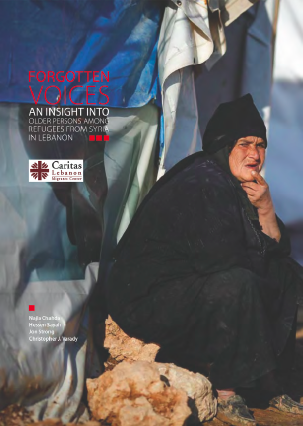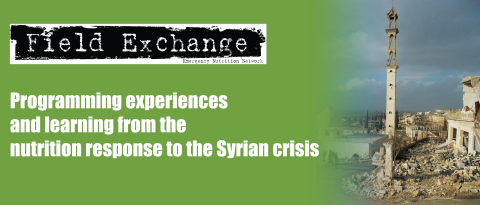Insight into experiences of older Syrian refugees in Lebanon
.jpg?w=225) Summary of report1
Summary of report1
This summary was prepared by Isabelle Saadeh Feghali, Coordinator at the Caritas Lebanon Migrant Centre, Beirut, Lebanon.
Caritas Lebanon Migrant Centre (CLMC) is pleased to share the results of this study on older persons among refugees coming from Syria. "Forgotten Voices" is an important opportunity to understand better the particular needs of older persons in the refugee population as well as to draw greater attention to this group which tends to be overlooked in many responses.
 Older persons constitute an increasingly larger share of the world's population, and refugees affected by both natural and man-made disasters. At the same time, their stage in life presents particular constraints, needs, and strengths of which the humanitarian community must take note. It is important that the humanitarian community create and implement age-appropriate, age-specific responses for older persons in a refugee crisis setting.
Older persons constitute an increasingly larger share of the world's population, and refugees affected by both natural and man-made disasters. At the same time, their stage in life presents particular constraints, needs, and strengths of which the humanitarian community must take note. It is important that the humanitarian community create and implement age-appropriate, age-specific responses for older persons in a refugee crisis setting.
Adequate nutrition is essential to maintain health. according to the World Health Organisation, this is especially needed by older people aged above 60 who might have special needs and require specialized diets due to chronic diseases, e.g. low salt intake for high blood pressure. These dietary requirements must be taken into consideration when planning the nutritional intervention for older persons during emergencies. Many other factors must also be taken into consideration such as the distribution method (avoiding long periods of standing, assistance needed to carry supplies), and the capacity to prepare and consume food available. Health, mental health, social circumstance, financial needs and the right to humanitarian assistance are all critical considerations.
.jpg?w=225) Building on its expertise in this field, CLMC collaborated with Johns Hopkins University to create a study designed to understand better the plight of older refugees from Syria. Key findings are shared here with a particular focus on the nutrition component.
Building on its expertise in this field, CLMC collaborated with Johns Hopkins University to create a study designed to understand better the plight of older refugees from Syria. Key findings are shared here with a particular focus on the nutrition component.
Method
The study utilized a mixed-methods design with quantitative and qualitative components. The quantitative component used a survey questionnaire to record basic demographic information, displacement history, and care-giving for the older person, non-communicable diseases, disabilities, nutrition, mental health, and functional status. Because there are few data available on the older refugee population in Lebanon, the survey focused on collecting the information related to a broad range of issues affecting older refugees rather than focus on a particular issue in-depth. Information about each survey participant was also gathered from the CLMC and PALWHO databases of registered refugees to add additional data for analysis. Open-ended interviews with older refugees, as well as humanitarian organisations providing aid to refugees in Lebanon, were added to provide a qualitative component to the study. Interviewing older refugees offered a valuable opportunity to explore issues in greater depth and to seek explanations for trends observed in the quantitative data. Meetings with the staff of humanitarian organizations were also arranged to learn about their experiences serving older refugees and ask if they had planned or implemented programs or assessments to address the specific needs of older refugees.
Profile of study sample
Taking place in early 2013, the study sampled approximately 10% of the older refugees registered in its database. A total of 210 refugees were included. Overall, 167 older Syrian refugees and 43 older Palestinian refugees responded to this study; these sample sizes allowed measurement of population characteristics within an error margin of ±7.6% for Syrian refugees and ±15% for Palestinian refugees coming from Syria2. The average respondent age was 68 years old (range 60-96 years). Most of the older Syrian refugees live in houses (39%) followed by tents (26%), apartments (23%) public buildings (6%), unfinished structures (3%) or other dwellings (3%).
At the time of the study, 55% of the Syrian refugees had registered as refugees and 15% had applied but not yet registered. The remaining 30% had not yet registered – this was probably due to a number of factors including recent arrival, lack of awareness of registration process, and fear of sharing personal information with the authorities.
Results
The results of the study were surprising in that they highlighted an overwhelming need. Some key data include:
- Of respondents, 74% noted that they were dependent on humanitarian assistance to meet their basic needs.
- Nearly all older refugees – 96% of Syrians and 100% of Palestinians – reported they had a family member who would take care of them if they were sick or help them if they had an emergency.
- 79% identified financial cost as their primary difficulty in seeing a doctor when they need medical care.
- 66% described their overall health status as bad or very bad. Nearly all respondents listed at least one chronic illness, with 60% having hypertension, 47% having diabetes, and 30% having some form of heart disease. Most respondents had multiple chronic illnesses.
- Most respondents had a number of disabilities including 47% reporting difficulty in walking and 24% reporting vision loss. Approximately 10% of older refugees were physically unable to leave their homes and 4% were bedridden. Large numbers of older persons require mobility aids such as walking canes and eye glasses.
- 87% of respondents were unable to afford medication they require regularly.
- Reducing meal sizes, skipping meals, and skipping fruits, vegetables, and meats were common among older persons. In fact, there was a tendency for older persons to eat less quantity or less quality food in order to provide better meals to younger members of the family.
- High numbers of older persons reported mental health concerns. Nearly 61% of respondents reported feeling anxious, while significant proportions of older persons reported feelings of depression, loneliness, and feeling a burden to their families.
Nutrition
The survey conducted on the frequency of consuming certain types of food found that older Syrian refugees consumed meat on an average of 1.4 days a week, while consuming dairy food, fruits and vegetables more frequently with an average of 3.1 and 3.2 respectively. Note, the survey was conducted in the winter of 2013, which may have affected food access. The study identified many factors associated with the frequency of eating from different food groups, especially the poor financial status of the refugees which is leading them to eat only bread for many days. Older Syrian refugees ate only bread 1.2 days per week, whereas older Palestinian refugees ate only bread 5.0 days per week. An age-related factor is also a significant influence, where older people in big households prefer to eat bread and keep the meat parcels for the young children. The frequency of eating certain food types was also related to refugee location - people living in tents in rural villages ate more fruits than bread, even while having poor financial status (tent settlements tend to be located near rural agricultural areas).
Older refugees reported a reduction in their food portion sizes for around 1.9 days a week, skipping a meal took place at an average of 1.5 days a week and not eating for around 0.5 days a week. Both Syrian and Palestinian older refugees frequently skip meals and go entire days without eating or eating only bread.
Discussion
.jpg?w=225) Despite these grim findings, CLMC found that older persons have a number of significant assets to bring to their families. Older persons tend to garner more respect and are able to be more effective negotiators with the host community. They also tend to have a positive effect on other members' mental health and can provide assistance with child care and household chores. CLMC concentrated its recommendations in this study on activating those strengths for the benefit of both the older person as well as his/her household.
Despite these grim findings, CLMC found that older persons have a number of significant assets to bring to their families. Older persons tend to garner more respect and are able to be more effective negotiators with the host community. They also tend to have a positive effect on other members' mental health and can provide assistance with child care and household chores. CLMC concentrated its recommendations in this study on activating those strengths for the benefit of both the older person as well as his/her household.
CLMC has also built on its history in working with the Palestinian refugees and tried to see if the lessons learned from that experience can be used in the Syrian context. CLMC used the same Outreach Methods which were mainly based on home visits which are critically important for health care. Furthermore CLMC included the Care for Chronic Illness in its health services. Moreover, CLMC used Medical Cards in order to keep all medical info with the refugees when needed. CLMC also introduced the Life-Cycle Education in order to increase the knowledge of its partners on how to treat older persons appropriately. In addition to that, CLMC trained caretakers who are mostly daughters or relatives in order to provide continuous support. Finally and in order not to isolate older persons who have minor mobility issues, CLMC introduced Mobility Aids in order to support those elderly people with walking canes, bed rails, etc.
For more information, contact: Isabelle Saadeh, email: isaade@eclmc.org
1See FSNAU website: www.fsnau.org
2FSNAU Press Release April 27, 2011: Somalia: Drought Impact Intensifies as Rains Delay


